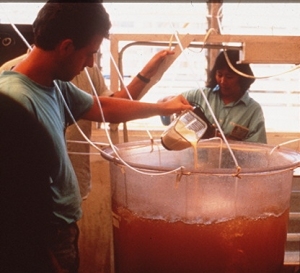 |
As mentioned above, the main factor affecting the nutritional value of Artemia as a food source for marine larval organisms is the content of the essential fatty acids (EFA) 20:5n-3 (EPA). Moreover, the content of the other EFA, docosahexaenoic acid (22:6n-3 or DHA), is always very low in Artemia. In view of the fatty acid deficiency in Artemia, research has been conducted to modify its lipid composition. Because of its primitive characteristics, Artemia facilitates a very convenient way to manipulate its biochemical composition. Since Artemia is nonse-lective in taking up particulate matter once it has molted into the second larval stage, i.e., about 8 h following hatching, simple methods could be developed to incorporate particulate products into Artemia prior to offering it as prey to the predator larva. This method of bioencapsulation is called Artemia enrichment or boosting. British, Japanese, and Belgian researchers developed enrichment products and procedures using selected microalgae and/ or microencapsulated products, yeast, and/or emulsified preparations, as well as self-emul-sifying concentrates and/or microparticulate products. The highest enrichment levels are obtained when using emulsified concentrates: freshly hatched nauplii are transferred to the enrichment tank at a density of 100 (for enrichment periods of >24 h) or 300 nauplii per milliliter (maximum 24-h enrichment period). The enrichment medium consists of disinfected seawater maintained at 25°C. The enrichment emulsion is added in consecutive doses of 300 ppm every 12 h. A strong aeration, using airstones, is of major importance to maintain dissolved oxygen levels above 4 ppm. Enriched nauplii are harvested after 24 to 48 h, thoroughly rinsed, and stored at temperatures below 10°C in order to ensure that highly unsaturated fatty acids (HUFAs) are not metabolized during storage). In this way, maximal incorporation levels of EPA and DHA can be reached, well above the maximal concentrations found in natural strains. Through this technique, other components such as vitamins, phospholipids, pigments, and therapeutics can be bioencapsulated in Artemia (Dhont et al.,1993). |